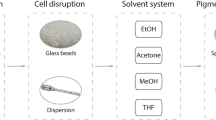Abstract
The harvesting method is a challenge in microalgae production since it may influence the bioactivity of the product. This study aimed to evaluate if electroflocculation biomass harvesting altered the antioxidant properties and toxicity of methanol extracts from the marine microalgae Isochrysis galbana and Phaeodactylum tricornutum, compared with the traditional centrifugation approach. Analyses were based on the elimination of the 2,2-diphenyl-1-picryl-hydrazyl (DPPH) free radical by the active ingredients from the extracts, thin-layer chromatography (TLC), calculation of IC50, and extract toxicity. Phaeodactylum tricornutum had similar DPPH-reactive fractions (with antioxidant activity) different from the β-carotene control in the TLC for both biomass-separating methods, but its IC50 was 63% higher for electroflocculation (lower antioxidant activity). Bands with antioxidant activity were absent in the TCL of I. galbana (non-DPPH-reactive) for both harvesting methods. The extracts did not present mortality for the study with the Artemia salina model. Therefore, electroflocculation can produce up to 10 times more biomass without cytotoxicity output but may decrease the antioxidant potential of microalgae extracts.




Similar content being viewed by others
References
Brand-Williams W, Cuvelier ME, Berset C (1995) Use of a free radical method to evaluate antioxidant activity. LWT Food Sci Technol 28:25–30
Cardozo KHM, Guaratini T, Barros MP, Falcão VR, Tonon AP, Lopes NP, Campos S, Torres MA, Souza AO, Colepicolo P, Pinto E (2007) Metabolites from algae with economical impact. Comp Biochem Physiol C Pharmacol Toxicol Endocrinol 146:60–78
Chen C-Y, Yeh K-L, Aisyah R, Lee D-J, Chang J-S (2011) Cultivation photobioreactor design and harvesting of microalgae for biodiesel production: a critical review. Bioresour Technol 102:71–81
Chisti Y (2004) Microalgae: our marine forests: handbook of microalgal culture: biotechnology and applied phycology, A. Richmond, editor, Blackwell, Oxford, 2004, pp. xvii+566, ISBN 0-632-05953-2. Biotechnol Adv 22:565–566
Gao S, Yang J, Tian J, Ma F, Tu G, Du M (2010) Electro-coagulation–flotation process for algae removal. J Hazard Mater 177:336–343
Japar AS, Takriff MS, Yasin NHM (2017) Harvesting microalgal biomass and lipid extraction for potential biofuel production: a review. J Environ Chem Eng 5:555–563
Jiménez J, Navarro MC, Montilla MP, Martin A, Martinez A (1993) Thymus zygis Oil: its effects on CCI4-induced hepatotoxicity and free radical scavenger activity. J Essent Oil Res 5:153–158
Kanimozhi P, Prasad NR (2009) Antioxidant potential of sesamol and its role on radiation-induced DNA damage in whole-body irradiated Swiss albino mice. Environ Toxicol Pharmacol 28:192–197
Kim SM, Kang S-W, Kwon O-N, Chung D, Pan C-H (2012) Fucoxanthin as a major carotenoid in Isochrysis aff galbana: Characterization of extraction for commercial application. J Korean Soc Appl Biol Chem 55:477–483
Lal A, Ghosh S, Das D (2018) Improvement in electrically induced biomass harvesting of Chlorella sp. MJ 11/11 for bulk biomass production. J Appl Phycol 30:979–993
Lamaison JL, Petitjean-Freytet C, Carnat AP, Carnat A (1988) Activites Antiradicalaires In Vitro D. ‘Huiles Essentielles. Plant Med Phytother 22:231–234
Lee AK, Lewis DM, Ashman PJ (2013) Harvesting of marine microalgae by electroflocculation: The energetics plant design and economics. Appl Energy 108:45–53
Levasseur M, Thompson PA, Harrison PJ (1993) Physiological acclimation of marine phytoplankton to different nitrogen sources. J Phycol 29:587–595
Meyer BN, Ferrigni NR, Putnam JE, Jacobsen LB, Nichols DE, McLaughlin JL (1982) Brine shrimp: a convenient general bioassay for active plant constituents. Planta Med 45:31–34
Mishra K, Ojha H, Chaudhury NK (2012) Estimation of antiradical properties of antioxidants using DPPH assay: a critical review and results. Food Chem 130:1036–1043
Molyneux P (2004) The use of the stable free radical diphenylpicrylhydrazyl (DPPH) for estimating antioxidant activity. Songklanakarin J Sci Technol 26:211–219
Nascimento IA, Cabanelas ITD, Santos JN, Nascimento MA, Sousa L, Sansone G (2015) Biodiesel yields and fuel quality as criteria for algal-feedstock selection: effects of CO2-supplementation and nutrient levels in cultures. Algal Res 8:53–60
Nguta JM, Mbaria JM, Gakuya DW, Gathumbi PK, Kabasa JD, Kiama SG (2011) Biological screening of Kenyan medicinal plants using Artemia salina L (Artemiidae). Pharmacol Online 2:458–478
Rajabi S, Ramazani A, Hamidi M, Naji T (2015) Artemia salina as a model organism in toxicity assessment of nanoparticles. Daru 23:20
Ramos L, Sousa L, Silva AF, Falcão VGO, Lima STC (2017) Evaluation of Electro-flocculation for biomass production of marine microalgae. Int J Energy Power Eng 11:391–394
Raut N, Panwar S, Vaidya R (2015) Electrofloculation for harvesting microalgae. Lambert Academic Publishing 60 p
Rodriguez-Garcia I, Guil-Guerrero JL (2008) Evaluation of the antioxidant activity of three microalgal species for use as dietary supplements and in the preservation of foods. Food Chem 108:1023–1026
Shimada K, Fujikawa K, Yahara K, Nakamura T (1992) Antioxidative properties of xanthan on the autoxidation of soybean oil in cyclodextrin emulsion. J Agric Food Chem 40:945–948
Silva APFS, Costa MC, Colzi Lopes A, Fares Abdala Neto E, Carrhá Leitão R, Mota CR, Bezerra dos Santos A (2014) Comparison of pretreatment methods for total lipids extraction from mixed microalgae. Renew Energy 63:762–766
Tepe B, Daferera D, Sokmen A, Sokmen M, Polissiou M (2005) Antimicrobial and antioxidant activities of the essential oil and various extracts of Salvia tomentosa Miller (Lamiaceae). Food Chem 90:333–340
Uduman N, Qi Y, Danquah MK, Forde GM, Hoadley A (2010) Dewatering of microalgal cultures: A major bottleneck to algae-based fuels. J Renew Sustain Energy 2:12701
Walne PL (1966) The effects of colchicine on cellular organization in Chlamydomonas. I. Light microscopy and cytochemistry. Am J Bot 53:908–916
Funding
The authors received financial support from the Fundação de Amparo à Pesquisa do Estado da Bahia (FAPESB).
Author information
Authors and Affiliations
Corresponding author
Ethics declarations
Conflicts of interest
The authors declare that they have no conflict of interest.
Additional information
Publisher’s note
Springer Nature remains neutral with regard to jurisdictional claims in published maps and institutional affiliations.
Rights and permissions
About this article
Cite this article
Ramos, L.C., Batista, R., Carneiro, D.C. et al. Evaluation of electroflocculation harvesting on the antioxidant activity and toxicity of extracts from the microalgae Isochrysis galbana and Phaeodactylum tricornutum. J Appl Phycol 32, 3853–3859 (2020). https://doi.org/10.1007/s10811-020-02265-3
Received:
Revised:
Accepted:
Published:
Issue Date:
DOI: https://doi.org/10.1007/s10811-020-02265-3




